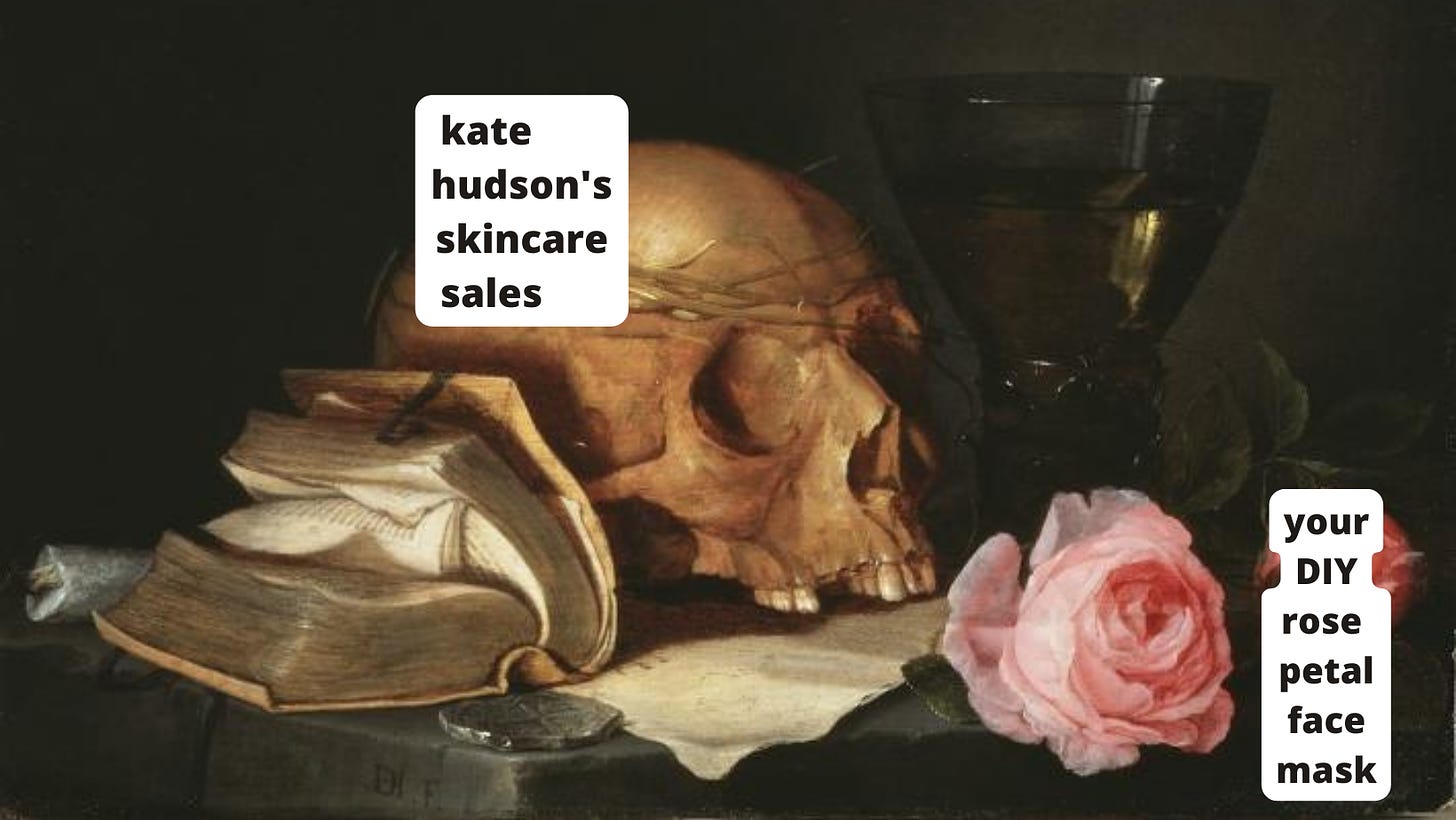How To DIY Kate Hudson's Face Mask (But Better)
Consider it a how-to in divesting from celebrity skincare.
As discussed in previous newsletters:
The skincare industry is out of its mind.
All three points were highlighted, circled, and underlined in “Kate Hudson’s Absurd Empire,” a recent article from fashion journalist Amy Odell (you really should subscribe to her newsletter, Back Row) that delves into the growing, Goopian “wellness” operation of Hollywood’s bubbliest nepotism baby.
When Odell asked to interview me for the piece, I was more than happy to share some thoughts on Hudson’s latest launch: a “Revitalizing Acacia and Rose Powder Face Mask,” her first foray into skincare. The product was made in collaboration with Juice Beauty and, as Women’s Wear Daily reported, has been in the works for a decade and a half. Ahem. A decade! And! A half!
from Back Row:
“They’re spinning it as this mask is 15 years in the making,” DeFino said. “It has ten very basic ingredients and honestly someone could whip this up in their kitchen and get better results from fewer ingredients.”
The main ingredient is rose petal, which anyone can buy at their local health food store and, as DeFino does, grind it up with a mortar and pestle, mix it with water, and apply to the face. She said, “There’s no need for 15 years of work to go into this.”
I don’t write much about topical skincare — topicals are probably the least important aspect of a skincare routine focused on actual skin health — but I do DIY this rose petal face mask fairly regularly, so I figured I’d share a bit more about it.
Rose has been a fan-favorite beauty ingredient for millennia, from Cleopatra to Kate Hudson. There are approximately 42 very good reasons why.
For starters, the ingredient has powerful anti-inflammatory properties, and inflammation is at the root of almost all skin issues. Rose can reduce redness and puffiness, calm active breakouts, and soothe irritation on contact.
When I interviewed dermatologist Dr. Lily Talakoub about rose for a Zoe Report article in 2019, she noted that “roses are filled with antioxidants that help fight free radicals caused by pollution and UV light.” Those antioxidants include vitamin C, polyphenols, and flavonoids — you know, all the ones the skincare influencers rave about, minus the plastic bottles and preservatives. Benefits include sealing in moisture, smoothing tone and texture, boosting collagen production, and promoting cellular turnover and self-exfoliation.
Rose has a reputation for being “anti-aging” as well, but as regular readers know, the entire concept of “anti-aging” is a goddamn scam. More often, “signs of aging” (loss of collagen, loss of moisture, dullness, hyperpigmentation) are actually signs of overexposure (to pollution, to sunlight, to climate, to processed foods, to stress, to skincare that strips away the protective layer of the skin barrier). Rose prevents “aging,” then, thanks to all those glorious antioxidants, which repair past damage and protect from future damage. Studies show that rose compounds have a particularly positive impact on fibroblast damage; fibroblasts being the cells that create collagen and elastin, the proteins responsible for making skin soft, supple, plump, bouncy, elastic, etcetera — in a word, resilient.
Speaking of resilience! Rose also has a bit of fat content, and fat is one of the best things you can foist upon your face. It reinforces the lipid layer, keeping the skin barrier hydrated, moisturized, and in tact. (This also has a lot to do with those “anti-aging” claims.)
Rose can alleviate symptoms of rosacea, acne, eczema, psoriasis, dermatitis, and garden-variety dry skin. It can soothe sunburn. It can clean and treat cuts and scrapes, thanks to its antiseptic properties. It can assist in healing scars and wounds. Through it all, the ingredient is unbelievably gentle.
It is wild — literally! — what a single rose petal has to offer. Your skin doesn’t really need more than this. And anyway, the more individual substances in a product, the more likely it is to disrupt your microbiome or degrade your skin barrier and lead to issues later on.
Instead of buying Hudson’s 17-ingredient mask, try DIYing this two-ingredient alternative.
What To Get:
Organic dried rose petals or rose buds (you can get these at your local health food store or herbal apothecary for a couple bucks, but I also like Maker + Merchant)
A mortar and pestle (a food processor works, too)
Water
What To Do:
Add a pinch or two of the rose petals/buds to the mortar and pestle/food processor
Grind into a fine powder
Mix with water until it reaches a paste-like consistency
Apply to clean skin
Let sit for 10, 20 minutes — however long you like
Rinse off with water
Sometimes I’ll mix the powder with plain yogurt (it’s nature’s lactic acid probiotic face mask!) or Mānuka honey (for all the reasons listed here) instead of water.
Although anyone can be allergic to anything, rose is generally considered safe for all skin types — it is, after all, known for its calming properties. Even those of us with the most sensitive skin (hi!) can handle it. You’d be hard-pressed to find a milder ingredient that packs a bigger punch.
Finally, to be fair, I want to note that the brand producing Hudson’s face mask, Juice Beauty, is one of the more ethical skincare companies out there. It’s transparent, has its own organic farms, cares about sustainability…
Counterpoint: celeb-led skincare and the consumerism (and mediocrity) it encourages can never be sustainable.
Consider this DIY a way to DI-vest from the celebrity beauty industrial complex.





I spray my face with organic rose hydrosol from mountain rose herbs. Would it have the same effect if I mixed that with manuka?
Tried this mask last night and my skin feels amazing now. Thank you for sharing!!!